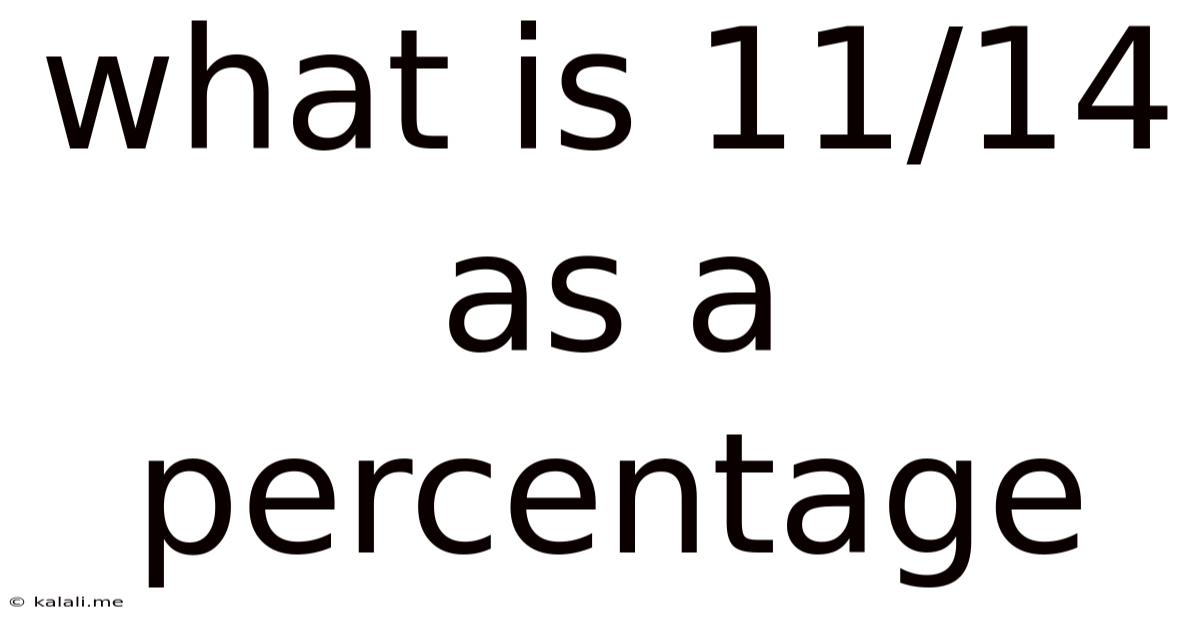What Is 11/14 As A Percentage
Kalali
Mar 08, 2025 · 4 min read

Table of Contents
What is 11/14 as a Percentage? A Comprehensive Guide to Fraction-to-Percentage Conversion
Converting fractions to percentages is a fundamental skill in mathematics with widespread applications in various fields, from finance and statistics to everyday life. Understanding this process allows for clearer comparisons and a more intuitive grasp of numerical relationships. This article delves deep into the conversion of the fraction 11/14 into a percentage, providing a detailed explanation of the methodology and exploring related concepts. We'll also examine different methods for solving similar problems and discuss the practical significance of this conversion.
Understanding Fractions and Percentages
Before we dive into the specific conversion of 11/14, let's refresh our understanding of fractions and percentages.
-
Fractions: A fraction represents a part of a whole. It consists of a numerator (the top number) and a denominator (the bottom number). The numerator indicates how many parts we have, while the denominator indicates the total number of equal parts the whole is divided into. In our case, 11/14 means we have 11 parts out of a total of 14 equal parts.
-
Percentages: A percentage is a way of expressing a number as a fraction of 100. The symbol "%" represents "per hundred." Percentages are widely used because they provide a standardized way to compare different proportions. For example, 50% means 50 out of 100, or 50/100, which simplifies to 1/2.
Method 1: Direct Conversion using Division
The most straightforward method to convert a fraction to a percentage involves dividing the numerator by the denominator and then multiplying the result by 100.
-
Divide the numerator by the denominator: 11 ÷ 14 ≈ 0.7857
-
Multiply the result by 100: 0.7857 × 100 = 78.57
Therefore, 11/14 is approximately 78.57%.
Method 2: Finding an Equivalent Fraction with a Denominator of 100
This method involves finding an equivalent fraction where the denominator is 100. This directly gives us the percentage because percentages are fractions out of 100. However, this method isn't always practical as it requires finding a common multiple. In the case of 11/14, it's not straightforward to find a simple equivalent fraction with a denominator of 100.
Let's illustrate this method with a simpler example: Convert 1/4 to a percentage.
-
We need to find a number that, when multiplied by 4, results in 100. This is 25 (4 x 25 = 100).
-
We multiply both the numerator and denominator by 25: (1 x 25) / (4 x 25) = 25/100
-
Since 25/100 means 25 out of 100, this is equivalent to 25%.
Method 3: Using a Calculator
Modern calculators make fraction-to-percentage conversions incredibly simple. Most calculators have a percentage function (%) or can handle direct fraction input. Simply enter 11/14 and then use the percentage function or multiply the decimal result by 100.
Understanding the Approximation
It's important to note that in the direct division method, we obtained an approximate value (78.57%). This is because the decimal representation of 11/14 is a non-terminating decimal (it continues infinitely). The approximation is perfectly acceptable for most practical purposes, but you can express the percentage with more decimal places for greater accuracy (e.g., 78.5714%).
Practical Applications of Fraction-to-Percentage Conversion
The ability to convert fractions to percentages has numerous real-world applications:
-
Finance: Calculating interest rates, discounts, and profit margins often involves converting fractions to percentages.
-
Statistics: Representing data proportions and probabilities using percentages provides a clear and easily understandable format.
-
Science: Expressing experimental results and data analysis frequently uses percentages.
-
Everyday Life: Understanding discounts in stores, calculating tips, or determining the completion of a task all utilize the principles of fraction-to-percentage conversion.
Expanding on the Concept: Working with More Complex Fractions
The techniques discussed above can be applied to more complex fractions as well. For instance, consider the fraction 22/35.
-
Divide the numerator by the denominator: 22 ÷ 35 ≈ 0.6286
-
Multiply the result by 100: 0.6286 × 100 = 62.86%
Therefore, 22/35 is approximately 62.86%.
Addressing Potential Errors and Troubleshooting
Common errors when converting fractions to percentages include:
-
Incorrect division: Ensure you accurately divide the numerator by the denominator.
-
Forgetting to multiply by 100: Remember that the result of the division must be multiplied by 100 to obtain the percentage.
-
Rounding errors: Be mindful of rounding errors, especially when dealing with non-terminating decimals. Specify the level of precision required for your application.
Conclusion: Mastering Fraction-to-Percentage Conversion
The ability to effortlessly convert fractions to percentages is a crucial skill. This article provided a comprehensive explanation of multiple methods for converting 11/14 to a percentage, highlighting the direct division method as the most efficient approach for this particular fraction. We also explored practical applications and addressed common errors. Mastering this skill enhances your mathematical proficiency and provides valuable tools for interpreting and analyzing data across various disciplines. The core concept is the understanding of the relationship between fractions and percentages – both represent parts of a whole, but percentages provide a standardized and readily comparable representation using a base of 100. Remember to choose the method most appropriate for the fraction and the required level of accuracy.
Latest Posts
Latest Posts
-
What Is The Diameter Of A Quarter
Jul 02, 2025
-
Spoon Gets Hot In A Bowl Of Soup
Jul 02, 2025
-
How Many Cups In A 16 Oz Sour Cream
Jul 02, 2025
-
How Many 1 4 Teaspoons Are In 1 Teaspoon
Jul 02, 2025
-
How Many Tbsp In A Dry Ounce
Jul 02, 2025
Related Post
Thank you for visiting our website which covers about What Is 11/14 As A Percentage . We hope the information provided has been useful to you. Feel free to contact us if you have any questions or need further assistance. See you next time and don't miss to bookmark.